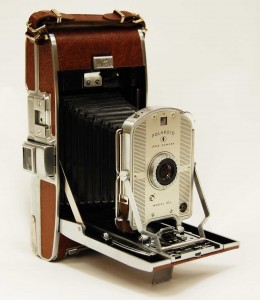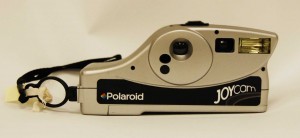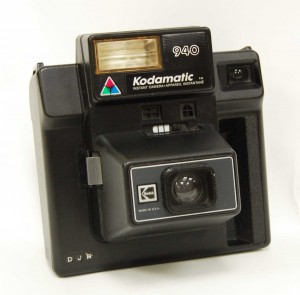In 1947, Edwin Land unveiled a new process that would change the direction of amateur photography. It was a one-step, one-minute process that produced a fully finished photograph, something no one had ever seen before. This process was the beginning of a new genre of creating photographs called instant photography. The camera that was made for this in-camera process was the Land camera, named for the inventor of synthetic polarizer and the instant film process, and the founder of the Polaroid Corporation. Many different models of these first Polaroid cameras, as well as many later models, can be viewed at Special Collections in the Toronto Metropolitan University Library Archives, along with examples of different Polaroid photographs and instant film.

Polaroid dominated the market for this unique and easy photographic process that was a huge hit with amateur and professional consumers. However, also among the shelves of Special Collections, are examples of cameras, prints and film made by a number of different manufacturing companies who tried to get in on this popular genre of photography. None were nearly as successful, as no one could compete with the Polaroid name or their (what is often referred to as brilliant) marketing campaign. Stars such as Steve Allen, Jack Paar, Sir Lawrence Olivier, Mariette Hartley & James Garner, Blyth Danner, Candice Bergen, and The Muppets loaned their talents to promoting Polaroid products at a time when many stars were wary of doing commercials.
Then, in 1976, Polaroid was finally faced with their first real competitor for the instant photography market, an already established manufacturer of photographic equipment and materials: the Eastman Kodak Company. But Polaroid was prepared to deal with their competition, and by 1986, all of Kodak’s instant photography films and cameras had been pulled from the market, and Kodak ceased to manufacture any products that would directly compete with Polaroid’s instant photography niche.

In fact, from 1963-1969, the Eastman Kodak Company had actually manufactured Polaroid’s instant film for them. At this time, Kodak was planning to introduce themselves to the market with a packfilm design, but later, after Polaroid released their SX-70 system in 1972, Kodak decided to go in a different direction and follow Polaroid with an integral type process instead. Although Kodak’s design differed from Polaroid’s in numerous ways, Polaroid filed suit against Kodak mere months after the release of the new products for the infringement of 12 Polaroid patents, accusing Kodak of illegally incorporating instant photography technology into their products. They claimed that during the 10 years the Eastman Kodak Company produced instant photography materials, they had cost the Polaroid Corporation $12 billion.

The final charges, announced in 1990, did not amount to $12 billion (what many considered a huge exaggeration), but at $909 million, they did come close to a billion. Found guilty on 7 of the 12 patent infringements after a trial in 1985, Kodak was forced out of instant photography the following year. The widely reported ruling was bad news for customers who had purchased a Kodak Instant camera.
The case did end favourably for Kodak though, especially after the high demands from Polaroid, who felt that Kodak had intentionally copied their technology. After a 14-year legal battle, in 1991 Kodak was finally ordered to pay Polaroid a total of $909 million, $925 million with interest, the largest settlement ever paid out until last year when Apple was awarded $1.049 billion in damages from Samsung infringements.
As part of the settlement, Kodak needed to provide compensation for customers who had bought any of their instant cameras between 1976 and 1986 and would no longer be able to purchase film to use in them. Owners of Kodak instant cameras were invited to call a toll free number and register themselves in order to receive a settlement packet. The packet was mailed out to those who registered, and provided customers with instructions of how to receive a rebate check or certificate, which often involved removing the name plate off of the front of the camera and mailing it in as proof of purchase.

The Eastman Kodak Company did manage to recover after the Polaroid lawsuit, and with the sales of their popular movie films were able to regain their success. Unfortunately, the company was much slower with the uptake of the digital market, and in 2012 filed for bankruptcy due to lack of demand for the primary products made by their company, photographic films.
If you wish to pay tribute to some of Kodak’s instant photography cameras, you can make an appointment to come and see examples such as the Kodamatic 940, the Kodak Colorburst models 250 and 300, and the Kodak Trimprint 940 (with nameplates still intact!), as well as a wide range of instant cameras, film, and equipment made by Polaroid and other instant photography manufacturers that Special Collections keeps in their Heritage Camera Collection and the Kodak Canada Corporate Archives.
More information
Have a look at some of the original television advertisements for the Kodak instant Cameras.
For more detailed information on how the instant photography process works, have a look at this article by Tom Harris at How Stuff Works.
To make an appointment with Ryerson Library Special Collections, contact:
asc@ryerson.ca
416-979-5000 ext 4996
Sources
Frezza, Bill. “Polaroid, Kodak, Apple: No One Escapes the Winds of Creative Destruction” Forbes, Sept 5, 2012. http://www.forbes.com/sites/billfrezza/2012/09/05/polaroid-kodak-apple-no-one-escapes-the-winds-of-creative-destruction.
Holusha, John. “Kodak Told it must Pay $909 Million.” New York Times (1923-Current File), Oct 13, 1990. http://ezproxy.lib.ryerson.ca/login?url=http://search.proquest.com/docview/108482495?accountid=13631.
“Instant Camera Settlement.” Kodak Service and Support. http://www.kodak.com/global/en/service/faqs/faq0098.shtml.
“Kodak Settles Dispute With Polaroid the Fight Over Instant-photography Technology Took 15 Years and Cost Kodak $925 Million in Damages.” The Inquirer, July 16, 1991. http://articles.philly.com/1991-07-16/business/25783982_1_polaroid-patents-instant-cameras-instant-photography-business.
McCarty, Dawn and Beth Jinks. “Kodak Files for Bankruptcy as Digital Era Spells End for Film.” Bloomberg, January 19, 2012. http://www.bloomberg.com/news/2012-01-19/kodak-photography-pioneer-files-for-bankruptcy-protection-1-.html.
Wurman, Richard Saul. Polaroid Access: Fifty Years. [S.I.] : Access Press, 1989.